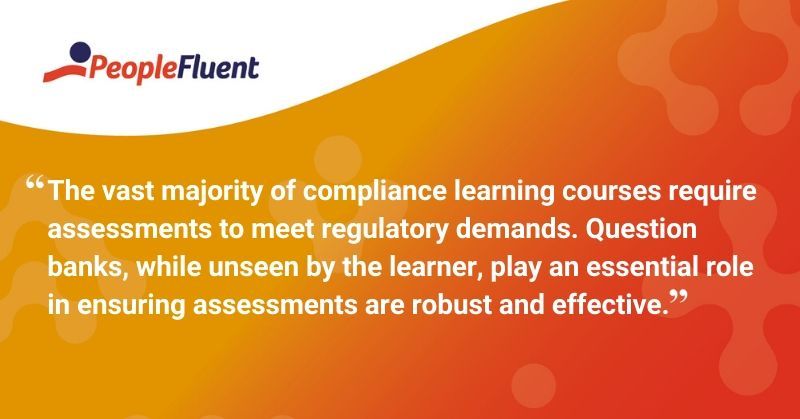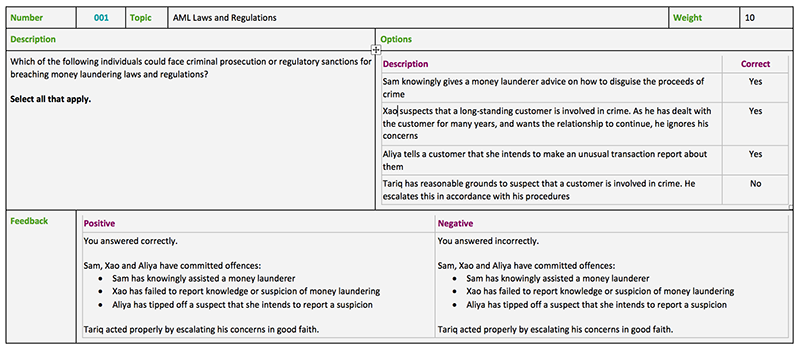Published: May 1, 2020Time to read: 6mins Category: Learning
4 Ways Question Banks Can Benefit Compliance eLearning
The vast majority of compliance learning courses require assessments to meet regulatory demands. Question banks, while unseen by the learner, play an essential role in ensuring assessments are robust and effective. In this blog post from our sister company governance, risk and compliance training specialists, Eukleia, Lead Learning Consultant, Emma Jourdan, explores four key ways question banks can benefit compliance learning.
Why Are Question Banks Important for Compliance Learning?
This article explores four key considerations when using question banks in compliance training. They are:
- How question banks can ensure assessment robustness
- How question banks can impact the wider learner journey
- The importance of mapping questions to learning objectives
- The role of data in question bank design, and why it’s important
Recommended related reading: 'The 13 Must-Have Features of a Learning Management System'
What Is a Question Bank?
A question bank is a list of questions and answers used in an online exam or assessment. There may be a single question bank to test knowledge and understanding of a range of topic areas, or any number of separate question banks linked to specific topics.
Traditionally, these assessments have been used to test a candidate's knowledge and understanding at the end of a learning module. Pass, and you complete the module or progress to the next step. Fail, and you typically have a chance to revisit course content and then take the test again.
The role of the question bank is, however, developing and they can now play a crucial role in creating engaging compliance training.

1) Question Banks Underpin Assessment Robustness
It’s important to get the underlying operating rules right. The underlying operating rules determine what will happen during assessments and any subsequent retakes. For example, if a candidate fails the questions on a particular topic, it’s reasonable to want them to answer further questions on that topic and to serve up different questions about that topic.
These operating rules add robustness and security to the assessment process. Randomizing question selection reduces the chance of one candidate passing on the answers to another. Additionally, if a user has to repeat an assessment it also allows the order of questions to be randomized. This reduces the chance of them seeing the same question again. There’s also the option to add new questions (depending on the rules set for the assessment). This ensures a candidate doesn’t simply pass on the second attempt by memorizing the question and answer order from the first attempt.

Handpicked for you: ‘3 Ways an LMS Takes the Confusion Out of Compliance Issues’
2) Question Banks Impact the Wider Learner Journey
In addition to the vital role they play to demonstrate an understanding of specific learning modules, question banks can play a surprisingly important, wider role, in the learner journey. The following learning design functions are all reliant on having extensive and well-categorized question banks to call upon:
Pre-Learning Assessments
Gauging levels of knowledge and competency at the outset of a learner journey allows you to personalize the content that is served up to the individual learner. This can be particularly relevant in compliance learning, where regulatory requirements may dictate frequency and course content.
As a learner, repeating training on a subject you know well can be demotivating. For the organization, it’s not an efficient use of time or money. Making a risk-assessed decision to reduce the time that competent learners spend on training is therefore beneficial for all involved.
A pre-assessment question bank may have specific requirements, especially if the expected result of passing is that the learner will receive less, albeit more targeted, content. To ensure robustness, pre-assessment questions may be harder—that is to say more detailed, or perhaps situation-based.
You might also like… ‘The Top 6 Benefits of a Modern Learning Management System’
Post-Learning Assessments
As part of a learner journey, post-learning assessments can help demonstrate competency as well as reducing knowledge decay (also known as the Forgetting Curve). The results can also be used to tailor any communication campaigns sent to learners or to help shape future training initiatives.
Gamification
Certain aspects of gamification rely on having an extensive question bank to be effective. One example is where leaderboards are built over time, with learners scored and ranked on results of questions answered. This approach only works effectively when fueled by a wide range of engaging questions.

More from the blog: ‘How a Compliance Training Solution Helps You Avoid Common Audit Errors’
3) The Importance of Mapping Questions to Learning Objectives
As with many aspects of learning design, it’s always important to consider what the purpose of the learning is. In other words: ‘What is the behavioral change we’d like to see?’ This becomes even more focused when applied to compliance training: ‘What is it that we need to show to a federal government agency or regulator that people understand?
Grouping questions—in much the same way that one may group content—is essential for compliance training. Questions within each bank are categorized or added to their own ‘bucket’ within a question bank. These buckets can then have rules and weightings applied, according to the importance of the topic.
So, while you may want your questions to be randomized, this approach means you can have ‘golden’ questions that are weighted to come up to a certain frequency or percentage ratio. This ensures that learners are assessed on the topics that really matter, and helps demonstrate to regulators that your assessments are robust and focused.
Also read: ‘5 Ways to Use Your LMS for Compliance Management’

4) Data Capture That Lets You Measure the Effectiveness of Compliance Learning
Each bank, bucket, and question has a unique ID attached. This is an essential element of setting up a question bank and is required to support the rules around weighting, frequency, and priority of each topic.
As questions are answered, individual learner records are built with the question ID and answer recorded. These records form part of a larger data collection that can show learner behaviors at departmental and organizational levels, as well as for specific learning modules
This data capture is essential for measuring the effectiveness of learning and improving the learner journey. It allows you to identify and spot trends, both on an individual and organizational level. This facilitates a continuous improvement approach to the learning content itself. If everyone is struggling with a particular question, is it truly a competency issue, or is the phrasing of the question itself the underlying issue?
While question banks may not be the star of the show, a little bit of care and consideration sets the foundation that helps engage your learners and helps you measure the effectiveness of your learning.
Want to know more? Download your copy of our short ebook ‘6 Things LMS Users in High-Consequence Industries Must Know’, or get in touch to find out how we can support your compliance learning needs.
A version of this post originally appeared on the Eukleia blog.